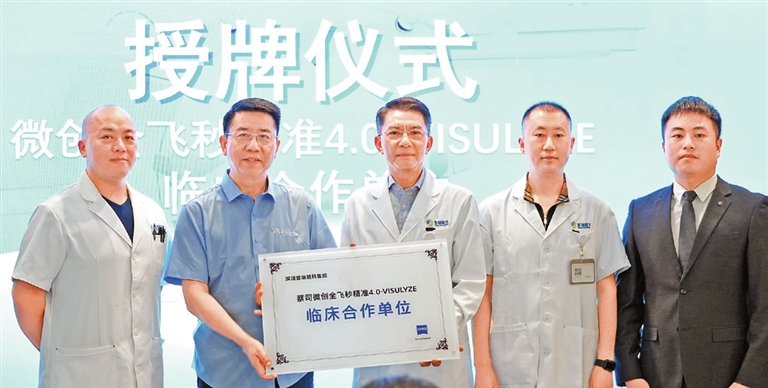

Debra Li debra_lidan@163.com IN this era of rapid technological advancement and algorithms reshaping our daily lives, the field of medical services is no exception. A workshop held Saturday morning at the Shenzhen branch of Bright Eye (“Purui” in pinyin), a private hospital chain listed on the ChiNext board, introduced patients to a software update, Zeiss Visulyze 4.0, being implemented for data analysis. This update significantly improves precision and reduces the side effects associated with SMILE surgery. SMILE, a minimally invasive procedure that corrects vision impairments like nearsightedness and astigmatism, has been performed on millions of patients across 80 countries. During the procedure, the femtosecond laser creates a small lens-shaped piece of corneal tissue (lenticule) within the cornea in less than 30 seconds. Liu Quan, the head of the hospital’s SMILE surgery team, explained that the lenticule is then removed through a small incision on the outer part of the eye, reshaping the cornea and correcting the refractive error. The laser’s high peak intensity and short pulse duration allow for precise creation of single micro-holes without affecting surrounding tissue. Liu, with 38 years of experience at the Zhongshan Ophthalmic Center, Sun Yat-sen University in Guangzhou, was among the pioneering doctors in China to practice SMILE surgery. He was recognized as the world’s leading practitioner of SMILE operations between 2012 and 2013. “Compared to other types of laser eye surgery, SMILE depends more heavily on a specific surgeon’s experience and expertise to achieve the best effect,” Liu said. “Many factors can influence the outcome of a SMILE operation, including a patient’s individual conditions such as their preoperative refraction, corneal curvature, age, and optical zone diameter. Variances in equipment, optometrists, surgeons, and environmental conditions such as surgery room temperature and humidity can all play a role.” While previously it depended on the surgeon’s expertise to interpret and readjust patient data obtained from various tests, Liu said, the upgraded software gives the surgeon better control of their overall refractive laser performance, taking a substantial step towards improving predictability of treatment outcomes. “Visulyze 4.0 can generate a regression model based on massive amounts of data to analyze and predict surgical outcomes, with the ability to create nomograms based on previous surgical results, so as to minimize systematic errors and enhance visual quality for patients,” Liu said. He added that with the assistance of this software, errors related to over- or under-correction can be minimized to within 0.001D. SMILE surgery has become a preferred choice for correcting myopia and astigmatism globally. In China alone, 1.15 million out of 2.4 million refractive surgeries in 2022 were SMILE procedures, accounting for 47.9%. Zeiss reported over 6 million SMILE surgeries in China, comprising two-thirds of the global total. The newly opened Shenzhen branch of Bright Eye Hospital, located in Nanshan District, has received more than 2,000 patients since its opening in May. Since launching its first hospital in Lanzhou, Gansu Province in 2005, the hospital chain has expanded to encompass 32 hospitals and four outpatient clinics across 23 Chinese cities. | 
